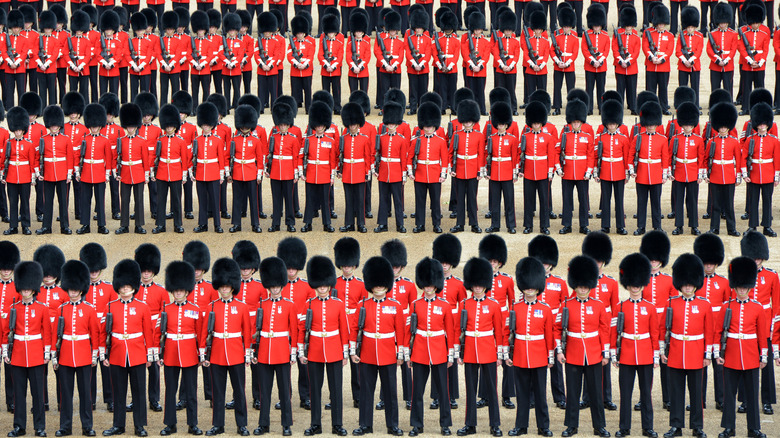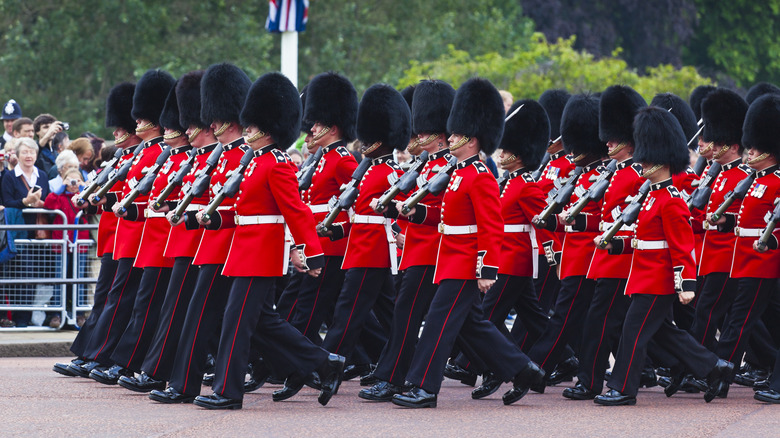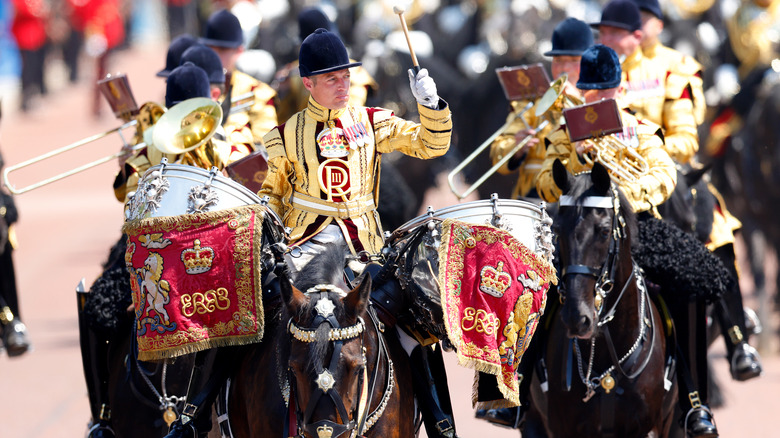The Ceremonial Military Roles For Trooping The Colour Explained
The British Isles are famously windswept and rainy, which explains a quirk of the timing of the Trooping the Colour, the lavish parade that takes place every year to mark the birthday of the British sovereign, who at present is King Charles III. Though Charles was born in November and his mother, Queen Elizabeth II, was born in April, the Trooping the Colour traditionally takes place on a Saturday in June because the month offers the best chance of decent weather. But while the weather may be changeable, the details of the ceremony itself have remained generally fixed since their inception, establishing a famous and iconic tradition that continues to attract crowds of spectators each year.
More than 1,400 ceremonial troops from the Household Regiments — the personal guards of the monarch — take part in the affair, supported by hundreds of musicians and other performers, who together march the length of the Mall to the Horse Guards Parade from Buckingham Palace, for the inspection of the monarch. The Trooping the Colour involving Charles III is actually the third Saturday of the month, with previous parades taking place for the inspection of the Major General and the Colonel of the Regiment the two previous Saturdays. However, not all of the soldiers taking part in Trooping the Colour are of the same class, nor are the Major General and the Colonel of the Regiment the only high-ranking officers to take part.
The Household Regiments
Though the British Royal Family themselves are famous around the world in the same way that celebrities from the entertainment industry often are, they are perhaps even more widely known by the symbols and icons that represent them. The crown itself, for instance, is reproduced as a seal on official documents and products that have the approval of the Royals.
But for many tourists on vacation in London looking for a brush with royalty, none of the sights are quite as iconic as that of the Household Division, who are often — though erroneously — referred to as beefeaters, the name of the warders that protect the Tower of London. Famously, Household Guards are trained to stand entirely still in the presence of onlookers. But their roles are not simply for show. The Household Division make up the King's personal security and are apparently battle-ready despite their traditional dress.
There are a total of five regiments in the Household Division: the Grenadier Guards, the Coldstream Guards, the Scots Guards, The Irish Guards, and the Welsh Guards, each of which is made up of several battalions. Each year, the Trooping of the Colour focuses on a single regiment. In 2023, it is the turn of the 1st Batallion Welsh Guards to Troop the Colour for the new King, Charles III, with six companies from the battalion taking part in battle maneuvers during the ceremony. A group of three soldiers, known as the Colour Company, break off from the companies for special inspection.
A 400-strong band, horses, planes, and gun salutes
While lavish hues are obviously the order of the day during the Trooping the Colour, the ceremony is also a cacophonous affair, with 400 musicians known as the Massed Bands of the Household Division accompanying the troops on display to create a multi-sensory feast for the crowds.
Alongside the infantry on display in the regimental march, the Royal Cavalry also troops, with around 200 horses involved in Trooping the Colour. All of this is overseen by the Officer in Command of the Parade, whose barked commands see him perform as something akin to the event's conductor.
The parade is then closed by a display by the Royal Air Force's Red Arrows, who perform a fly-past for the assembled public and the Royal Family themselves, who watch the finale from the balcony of Buckingham Palace, followed by a 41-gun salute from The King's Troop Royal Horse Artillery at noon.


